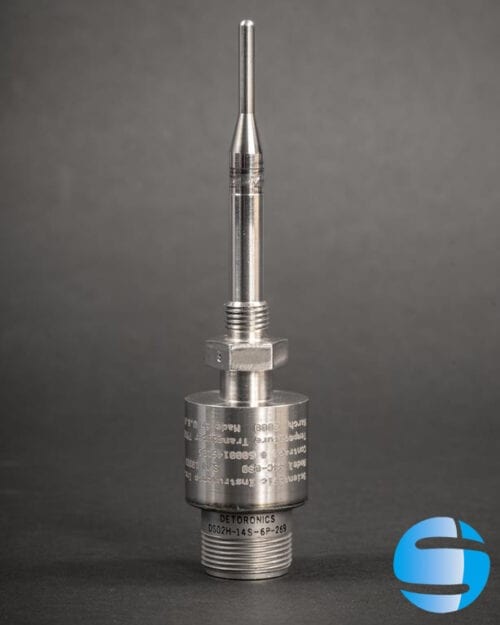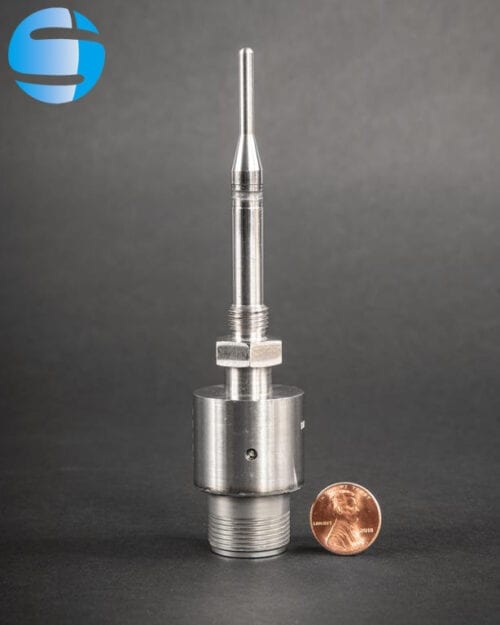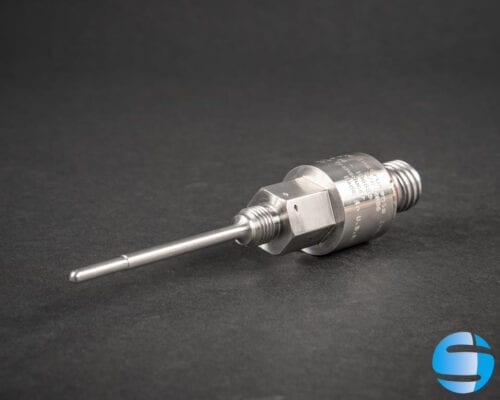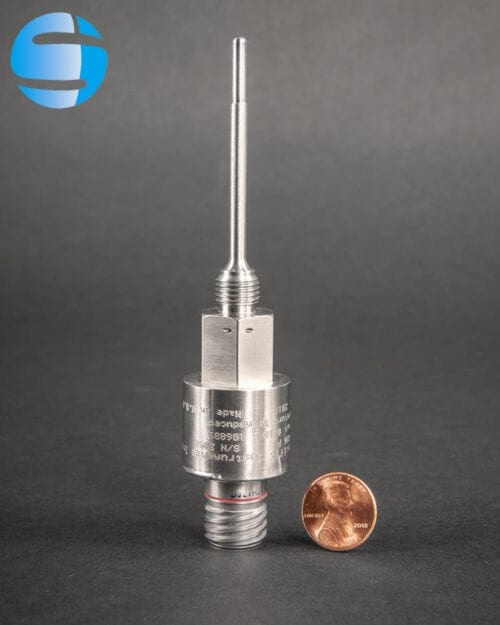-
Out of stock

 The Series 44 cryogenic temperature probes utilize either a 200Ω or 1000Ω platinum resistance thermometer (PRT), or a silicon diode (SD) thermometer and are constructed of stainless steel. The 44B design is designed for operation from -40°C to +200°C and the 44C from -196°C to +125°C. The probes are designed to withstand the extreme conditions—mechanical, thermal, and electrical—expected of their process environments. They are hermetically sealed with the sensing element embedded within a thermal epoxy at the stem’s tip. These probes are recommended for direct immersion with your application service media and can withstand extreme pressure environments. Please see below for detailed specifications.
The Series 44 cryogenic temperature probes utilize either a 200Ω or 1000Ω platinum resistance thermometer (PRT), or a silicon diode (SD) thermometer and are constructed of stainless steel. The 44B design is designed for operation from -40°C to +200°C and the 44C from -196°C to +125°C. The probes are designed to withstand the extreme conditions—mechanical, thermal, and electrical—expected of their process environments. They are hermetically sealed with the sensing element embedded within a thermal epoxy at the stem’s tip. These probes are recommended for direct immersion with your application service media and can withstand extreme pressure environments. Please see below for detailed specifications. -
Out of stock

 Discontinued, Please See Our New Series 56 Probes The Series 44 cryogenic temperature probes utilize either a 200Ω or 1000Ω platinum resistance thermometer (PRT), or a silicon diode (SD) thermometer and are constructed of stainless steel. The 44B design is designed for operation from -40°C to +200°C and the 44C from -196°C to +125°C. The Series 44 is also available with silicon diode sensing elements (54D) for operation in the most extreme cryogenic temperature regimes down to -269°C.
Discontinued, Please See Our New Series 56 Probes The Series 44 cryogenic temperature probes utilize either a 200Ω or 1000Ω platinum resistance thermometer (PRT), or a silicon diode (SD) thermometer and are constructed of stainless steel. The 44B design is designed for operation from -40°C to +200°C and the 44C from -196°C to +125°C. The Series 44 is also available with silicon diode sensing elements (54D) for operation in the most extreme cryogenic temperature regimes down to -269°C. -
Out of stock

 Discontinued, Please See Our New Series 56 Probes Scientific Instruments offers a variety of temperature probes that allow mounting in hazardous environments. These units are constructed of stainless steel, hermetically sealed, and the sensing element is mounted in a thermal epoxy at the tip. The probes are designed for direct immersion or thermowell applications. The basic sensing elements used in the Series 46 temperature probe assemblies, designed and manufactured by Scientific Instruments, is the Si410 silicon diodes. These diodes are rugged, wide-range (1.5K to 450K) sensing elements which offer excellent interchangeability to standard temperature-versus-voltage curves. This interchangeability allows a user to employ any given temperature probe assembly in his facility while using a single temperature curve for signal conditioning requirements. This model has been used for ground support and flight hardware. See below for detailed specifications.
Discontinued, Please See Our New Series 56 Probes Scientific Instruments offers a variety of temperature probes that allow mounting in hazardous environments. These units are constructed of stainless steel, hermetically sealed, and the sensing element is mounted in a thermal epoxy at the tip. The probes are designed for direct immersion or thermowell applications. The basic sensing elements used in the Series 46 temperature probe assemblies, designed and manufactured by Scientific Instruments, is the Si410 silicon diodes. These diodes are rugged, wide-range (1.5K to 450K) sensing elements which offer excellent interchangeability to standard temperature-versus-voltage curves. This interchangeability allows a user to employ any given temperature probe assembly in his facility while using a single temperature curve for signal conditioning requirements. This model has been used for ground support and flight hardware. See below for detailed specifications. -
Out of stock

 Scientific Instruments offers a variety of temperature probes that allow mounting in hazardous environments. These units are constructed of stainless steel, hermetically sealed, and the sensing element is mounted in a thermal epoxy at the tip. The probes are designed for direct immersion or thermowell applications. The basic sensing elements used in the Series 56 temperature probe assemblies, designed, and manufactured by Scientific Instruments, are the SI-540 silicon diodes. These diodes are rugged, wide-range (1.5K to 450K) sensing elements which offer excellent interchangeability to standard temperature-versus-voltage curves. This interchangeability allows a user to employ any given temperature probe assembly in his facility while using a single temperature curve for signal conditioning requirements. This model has been used for cryogenic hydrogen applications, ground support, and flight hardware. See below for detailed specifications.
Scientific Instruments offers a variety of temperature probes that allow mounting in hazardous environments. These units are constructed of stainless steel, hermetically sealed, and the sensing element is mounted in a thermal epoxy at the tip. The probes are designed for direct immersion or thermowell applications. The basic sensing elements used in the Series 56 temperature probe assemblies, designed, and manufactured by Scientific Instruments, are the SI-540 silicon diodes. These diodes are rugged, wide-range (1.5K to 450K) sensing elements which offer excellent interchangeability to standard temperature-versus-voltage curves. This interchangeability allows a user to employ any given temperature probe assembly in his facility while using a single temperature curve for signal conditioning requirements. This model has been used for cryogenic hydrogen applications, ground support, and flight hardware. See below for detailed specifications. -
 For needs pertaining to alignment of multiple strands, this parallel-bonded, color-coded construction offers benefits for many applications. When concern for space, weight, and reliability is crucial and consistent capacitance and impedance characteristics are required, these magnet wire outperforms windings using two separate magnet wires. Production users benefit from increased layer winding speeds, tighter windings that deliver more power in less space, reduced labor and handling. Color coding assists in conductor identification and reduces termination errors.
For needs pertaining to alignment of multiple strands, this parallel-bonded, color-coded construction offers benefits for many applications. When concern for space, weight, and reliability is crucial and consistent capacitance and impedance characteristics are required, these magnet wire outperforms windings using two separate magnet wires. Production users benefit from increased layer winding speeds, tighter windings that deliver more power in less space, reduced labor and handling. Color coding assists in conductor identification and reduces termination errors.Phosphor Bronze Alloy
This alloy is widely used for most types of springs because of its high strength and resistance to corrosion and fatigue. It is also used in switches, relays, contacts, and fasteners.
